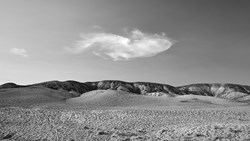Photographs of Death Valley Amid a Record Setting Heat Wave

When the temperature hits 137 degrees, most people run inside to find an air conditioner. Hawaii photographer David Murphey heads outdoors to photograph the desert landscape.
Aside from just being plain hot, photographing in the extreme heat presented unique difficulties. The blistering temperature caused camera failures over the 5 days shooting in Death Valley. "Having your camera turn off by itself really puts a damper in any shoot," says David. His Canon 5D mkIII kept loosing its connection with the battery. Surprisingly, his backup camera, a Canon 6D worked fine.
The solution: Ice cubes in a plastic baggie at the bottom of the camera bag made for a "mini cooler". It kept the batteries cool enough to swap in the camera while shooting. The low humidity and heat evaporated any excess water, so there wasn't any damage to the lenses or camera bodies.
Another challenge was getting clean photographs while most of the valley was filled with smoke. The nearby Mt Charleston wildfires are still burning out of control, and the smoke has been drifting west into Death Valley.
Despite all the issues, David finished the week with a fine set of photographs.
http://www.davidmurphey.com/project/death-valley
On June 30th, the temperature peaked at 137 degrees in Badwater Basin. Badwater is 282 feet below sea level and the down draft from the mountains create an oven like effect there. The official temperature taken by the National Park Service at Furnace Creek was 129 degrees, 17 miles north of Badwater.
Videos

